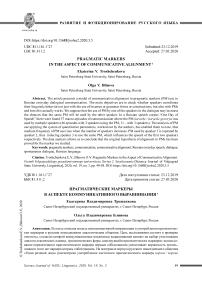Pragmatic markers in the aspect of communicative alignment
Автор: Troshchenkova Ekaterina V., Blinova Olga V.
Журнал: Вестник Волгоградского государственного университета. Серия 2: Языкознание @jvolsu-linguistics
Рубрика: Развитие и функционирование русского языка
Статья в выпуске: 3 т.19, 2020 года.
Бесплатный доступ
The article presents a model of communicative alignment in pragmatic markers (PM) use in Russian everyday dialogical communication. The main objectives are to check whether speakers coordinate their linguistic behavior not just with the use of lexemes or grammar forms or constructions, but also with PMs and how this actually works. We suppose that the use of PM by one of the speakers in the dialogue may increase the chances that the same PM will be used by the other speaker. In a Russian speech corpus “One Day of Speech” there were found 57 macro-episodes of communication where the PM koroche / koroche govorya was used by multiple speakers (46 episodes with 2 speakers using the PM, 11 - with 3 speakers). The analysis of PM use applying the system of quantitative parameters, worked out by the authors, has enabled them to note, that medium frequency of PM use rises when the number of speakers increases. PM used by speaker 1 is repeated by speaker 2, thus inducing speaker 3 to use the same PM, which influences the speech of the first two speakers respectively. The data analysis allows us to conclude that the original hypothesis of alignment in PMs has been proved for the marker we studied.
Pragmatic markers, communication, communicative alignment, russian everyday speech, dialogue, spontaneous dialogue, russian language
Короткий адрес: https://sciup.org/149131567
IDR: 149131567 | УДК: 811.161.1’27 | DOI: 10.15688/jvolsu2.2020.3.5
Список литературы Pragmatic markers in the aspect of communicative alignment
- Bock J.K., 1986. Syntactic Persistence in Language Production. Cognitive Psychology, vol. 18, no. 3, pp. 355-387. DOI: https://doi.org/10.1016/0010-0285(86)90004-6.
- Bogdanova-Beglaryan N.V., Sherstinova T.Ju., Blinova, O.V., Martynenko, G.Ja., 2018a. Korpus «Odin rechevoj den'» v issledovanijah sociolingvisticheskoj variativnosti russkoj razgovornoj rechi [Corpus "One Speech Day" for Studying Sociolinguistic Variation of Everyday Speech]. Analiz razgovornoj russkoj rechi (AR3-2017): Trudy sed'mogo mezhdisciplinarnogo seminara [Analysis of Russian Spoken Language (AR3- 2017): Papers of the 7th International Interdisciplinary Seminar]. D. A. Kocharov, P. A. Skrelin (eds.). SPb.: Politehnika-print. pp. 14-20.
- Bogdanova-Beglarian N., Sherstinova T., Blinova O., Martynenko G., Baeva E., 2018b. Towards a Description of Pragmatic Markers in Russian Everyday Speech. Lecture Notes in Computer Science (including subseries Lecture Notes in Artificial Intelligence and Lecture Notes in Bioinformatics), vol. 11096: Speech and Computer. 20th International Conference, SPECOM 2018, Leipzig, Germany, September 1822, 2018, Proceedings. Springer Publishing Company, pp. 42-48. DOI: https://doi.org/ 10.1007/978-3-319-99579-3_5.
- Bogdanova-Beglaryan N.V, Sherstinova T.Yu., Blinova O.V, Martynenko GYa., 2019a. Korpus russkogo yazyka povsednevnogo obshcheniya «Odin rechevoy den'»: tekushcheye sostoyaniye i perspektivy [Russian everyday speech corpus "One Day of Speech": current state and perspectives]. Trudy Instituta russkogo yazyka im. V.V. Vinogradova [Proceedings of the V.V. Vinogradov Russian Language Institute], vol. 21, pp. 101-110.
- Bogdanova-Beglarian N., Sherstinova T., Blinova O., Martynenko G., 2019b. Pragmatic Markers Distribution in Russian Everyday Speech: Frequency Lists and Other Statistics for Discourse Modeling. Lecture notes in computer science. 11658 LNAI. Heidelberg, SpringerVerlag GmbH, pp. 433-443. DOI: https://doi.org/ 10.1007/978-3-030-26061-3_44.
- Borisova I.N., 2009. Russkiy razgovornyy dialog: Struktura i dinamika [Russian Spoken Dialogue: Structure and Dynamics]. Moscow, LIBROKOM Publ. 320 p.
- Branigan H.P., Pickering M.J., Cleland A.A., 2000. Syntactic Co-ordination in Dialogue. Cognition, vol. 75, iss. 2, pp. B13-B25. DOI: https://doi.org/ 10.1016/s0010-0277(99)00081-5.
- Brinton L.J., 2017. The Evolution of Pragmatic Markers in English: Pathways of Change. Cambridge University Press. 344 p. DOI: https:/ /doi.org/10.1017/9781316416013.
- Clark A., Chalmers D.J., 1998. The Extended Mind. Analysis, vol. 58, no. 1, pp. 7-19. DOI: https:// doi.org/10.1093/analys/58.1.7.
- Cowley S.D., Kravchenko A.V., 2006. Dinamika kognitivnykh protsessov i nauki o yazyke [Dynamics of Cognitive Processes and Language Sciences]. Voprosyyazykoznaniya [Topics in the Study of Language], no. 6, pp. 133-140.
- Du Bois J.W., 2007. The Stance Triangle. Englebretson R., ed. Stancetaking in Discourse: Subjectivity, Evaluation, Interaction. Amsterdam, John Benjamins Publishing Company, pp. 139-182. DOI: https://doi.org/10.1075/pbns. 164.07du.
- Fraser B., 1996. Pragmatic Markers. Pragmatics, vol. 6, no. 2, pp. 167-190. DOI: https://doi.org/10.1075/ prag.6.2.03fra.
- Fusaroli R., R^czaszek-Leonardi J., Tylén K., 2014. Dialogue as interpersonal synergy. New Ideas in Psychology, vol. 32, pp. 147-157. DOI: https:/ /doi .org/10.1016/j. newideapsych.2013.03.005.
- Fusaroli R., Tylén K., 2016. Investigating Conversational Dynamics: Interactive Alignment, Interpersonal Synergy, and Collective Task Performance. Cognitive Science, vol. 40, no. 1, pp. 145-171. DOI: https://doi.org/10.1111/cogs. 12251.
- Gries S.T., 2005. Syntactic Priming: A Corpus-Based Approach. Journal of Psycholinguistic Research, no. 34, pp. 365-399. DOI: https:// doi.org/10.1007/s10936-005-6139-3.
- Hutchins E., 1995. Cognition in the Wild, MIT Press. 381 p.
- Pickering M.J, Ferreira V.S, 2008. Structural Priming: A Critical Review. Psychological Bulletin, vol. 134, no. 3, pp. 427-459. DOI: https://doi.org/ 10.1037/0033-2909.134.3.427.
- Pickering M.J., Garrod S., 2004. Toward a Mechanistic Psychology of Dialogue. Behavioral and Brain Sciences, no. 27, pp. 169-225. DOI: https:// doi.org/10.1017/S0140525X04000056.
- Pickering M.J., Garrod S., 2006. Alignment as the Basis for Successful Communication. Research on Language and Computation, vol. 4, no. 2, pp. 203-228. DOI: https://doi.org/10.1007/s11168-006-9004-0.
- Reinemann C., ed., 2014. Political Communication. Berlin, Mouton de Gruyter. 659 p.
- Sakita T.I., 2013. Discourse Markers as Stance Markers: Well in Stance Alignment in Conversational Interaction. Pragmatics and Cognition, vol. 21, no. 1, pp. 81-116.
- Sherstinova T.Yu., 2009. The Structure of the ORD Speech Corpus of Russian Everyday Communication. Matousek V. and Mautner P., eds. 12th International Conference, TSD 2009: Text, Speech and Dialogue, Pilsen, Czech Republic, September 13-17, 2009. Proceedings. Pilsen, Springer, pp. 258-265. DOI: 0https:// doi.org/10.1007/978-3-642-04208-9_37.


